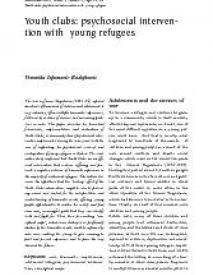Youth clubs: psychosocial intervention with young refugees
The war in former Yugoslavia (1991-95) exposed hundreds of thousands of children and adolescents to very intensive, often multiple traumatic experiences, followed by a chain of chronic and increasing problems in exile. This paper describes the theoretical framework, implementation and evaluation of Youth Clubs, a community-based psychosocial intervention implemented during the war years with the
aim of supporting the psychosocial recovery and reintegration of young refugees in Serbia. The evaluation study confirmed that Youth Clubs are an efficient intervention that reduces suffering and prevents a negative outcome of traumatic experience in the majority of adolescent refugees. The author discusses the hypothesis that the ‘healing’ effect of the Youth Clubs intervention might be due to providing norms and context for the interpretation and understanding of traumatic events, offering young people opportunities to master the reality and find some new, meaningful goals that they can identify with and fight for. Thus, their pre-existing “conceptual maps”, which were destroyed or profoundly shaken by the traumatic events, could be replaced by new ones enabling the young to give meaning to past and present experience and to pave the way towards the future.
Geachte bezoeker,
De informatie die u nu opvraagt, kan door psychotraumanet niet aan u worden getoond. Dit kan verschillende redenen hebben,
waarvan (bescherming van het) auteursrecht de meeste voorkomende is. Wanneer het mogelijk is om u door te verwijzen naar de bron
van deze informatie, dan ziet u hier onder een link naar die plek.
Als er geen link staat, kunt u contact opnemen met de bibliotheek,
die u verder op weg kan helpen.
Met vriendelijke groet,
Het psychotraumanet-team.
Reference:
Veronika Ispanovic-Radojkovic
| 2003
In: Intervention: the international journal of mental health, psychosocial work and counselling in areas of armed conflict, ISSN 1571-8883 | 1 | 3 | 38-44
http://www.interventionjournal.com/sites/default/files/38-44%20Veronika.pdf
In: Intervention: the international journal of mental health, psychosocial work and counselling in areas of armed conflict, ISSN 1571-8883 | 1 | 3 | 38-44
http://www.interventionjournal.com/sites/default/files/38-44%20Veronika.pdf


